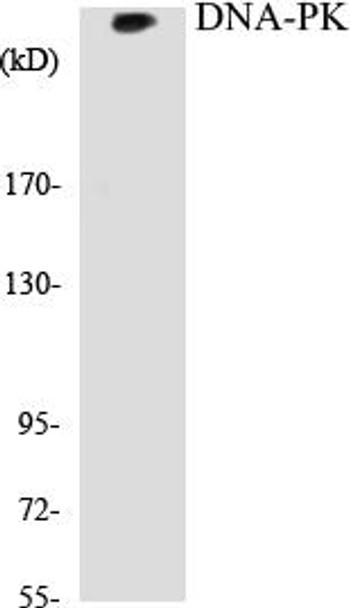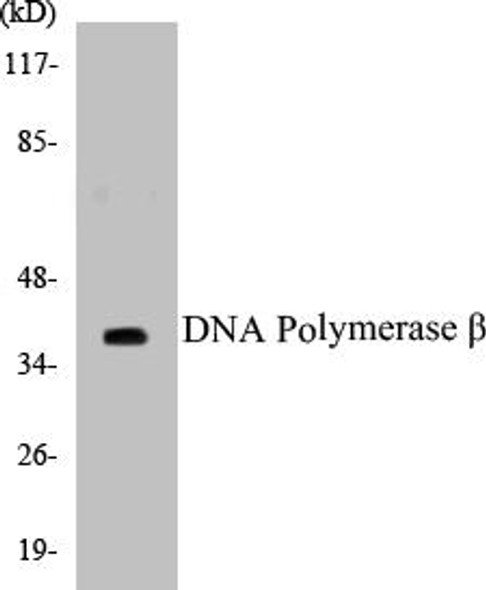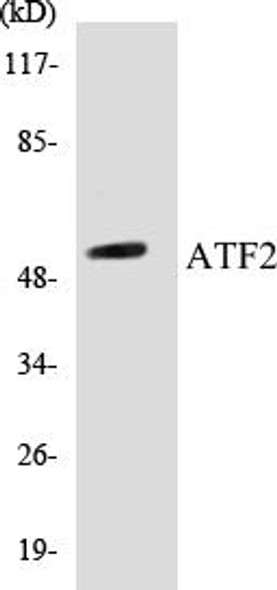Cell Biology
DNA-PK Colorimetric Cell-Based ELISA Kit
- SKU:
- CBCAB00078
- Product Type:
- ELISA Kit
- ELISA Type:
- Cell Based
- Research Area:
- Cell Biology
- Reactivity:
- Human
- Reactivity:
- Mouse
- Detection Method:
- Colorimetric
Description
| Product Name: | DNA-PK Colorimetric Cell-Based ELISA |
| Product Code: | CBCAB00078 |
| ELISA Type: | Cell-Based |
| Target: | DNA-PK |
| Reactivity: | Human, Mouse |
| Dynamic Range: | > 5000 Cells |
| Detection Method: | Colorimetric 450 nmStorage/Stability:4°C/6 Months |
| Format: | 96-Well Microplate |
The DNA-PK Colorimetric Cell-Based ELISA Kit is a convenient, lysate-free, high throughput and sensitive assay kit that can detect DNA-PK protein expression profile in cells. The kit can be used for measuring the relative amounts of DNA-PK in cultured cells as well as screening for the effects that various treatments, inhibitors (ie siRNA or chemicals), or activators have on DNA-PK.
Qualitative determination of DNA-PK concentration is achieved by an indirect ELISA format. In essence, DNA-PK is captured by DNA-PK-specific primary antibodies while the HRP-conjugated secondary antibodies bind the Fc region of the primary antibody. Through this binding, the HRP enzyme conjugated to the secondary antibody can catalyze a colorimetric reaction upon substrate addition. Due to the qualitative nature of the Cell-Based ELISA, multiple normalization methods are needed:
| 1. | A monoclonal antibody specific for human GAPDH is included to serve as an internal positive control in normalizing the target absorbance values. |
| 2. | Following the colorimetric measurement of HRP activity via substrate addition, the Crystal Violet whole-cell staining method may be used to determine cell density. After staining, the results can be analysed by normalizing the absorbance values to cell amounts, by which the plating difference can be adjusted. |
| Database Information: | Gene ID: 5591, UniProt ID: P78527, OMIM: 600899, Unigene: Hs.491682 |
| Gene Symbol: | PRKDC |
| Sub Type: | None |
| UniProt Protein Function: | DNAPK: an atypical protein kinase of the PIKK family. Involved in DNA nonhomologous end joining (NHEJ) required for double-strand break (DSB) repair and V(D)J recombination. and modulation of transcription. Must be bound to DNA to express its catalytic properties. Promotes processing of hairpin DNA structures in V(D)J recombination by activation of the hairpin endonuclease artemis (DCLRE1C). The assembly of the DNA-PK complex at DNA ends is also required for the NHEJ ligation step. Required to protect and align broken ends of DNA. May also act as a scaffold protein to aid the localization of DNA repair proteins to the site of damage. Found at the ends of chromosomes, suggesting a further role in the maintenance of telomeric stability and the prevention of chromosomal end fusion. Also involved in modulation of transcription. Defects cause severe combined immune deficiency (SCID) which is characterized by a lack of mature functional lymphocytes and a high susceptibility to lethal opportunistic infections. Required for repair of radiation-induced dsDNA breaks. Loss of function in mice or horses leads to the SCID (severe combined immune deficiency) phenotype due to failure of immunoglobulin rearrangement. Target of mutation in mismatch repair-deficient colorectal cancer. Inhibitor: KU-7059. 2 isoforms of the human protein are produced by alternative splicing. |
| UniProt Protein Details: | Protein type:EC 2.7.11.1; Kinase, protein; Protein kinase, Ser/Thr (non-receptor); DNA repair, damage; Protein kinase, atypical; Nucleolus; ATYPICAL group; PIKK family; DNAPK subfamily Chromosomal Location of Human Ortholog: 8q11 Cellular Component: nucleoplasm; transcription factor complex; membrane; nucleolus; DNA-dependent protein kinase complex; cytosol Molecular Function:protein serine/threonine kinase activity; protein binding; enzyme binding; DNA binding; DNA-dependent protein kinase activity; transcription factor binding; ATP binding; protein kinase activity Biological Process: positive regulation of apoptosis; heart development; germ cell programmed cell death; rhythmic process; T cell differentiation in the thymus; double-strand break repair via nonhomologous end joining; negative regulation of protein amino acid phosphorylation; double-strand break repair; positive regulation of interferon type I production; response to gamma radiation; telomere maintenance; pro-B cell differentiation; somitogenesis; immunoglobulin V(D)J recombination; protein destabilization; B cell lineage commitment; protein modification process; regulation of circadian rhythm; DNA repair; double-strand break repair via homologous recombination; peptidyl-serine phosphorylation; T cell lineage commitment; DNA damage response, signal transduction resulting in induction of apoptosis; cellular response to insulin stimulus; innate immune response; T cell receptor V(D)J recombination; positive regulation of transcription from RNA polymerase II promoter; brain development Disease: Immunodeficiency 26 With Or Without Neurologic Abnormalities |
| NCBI Summary: | This gene encodes the catalytic subunit of the DNA-dependent protein kinase (DNA-PK). It functions with the Ku70/Ku80 heterodimer protein in DNA double strand break repair and recombination. The protein encoded is a member of the PI3/PI4-kinase family.[provided by RefSeq, Jul 2010] |
| UniProt Code: | P78527 |
| NCBI GenInfo Identifier: | 38258929 |
| NCBI Gene ID: | 5591 |
| NCBI Accession: | P78527.3 |
| UniProt Secondary Accession: | P78527,P78528, Q13327, Q13337, Q14175, Q59H99, Q7Z611 Q96SE6, Q9UME3, |
| UniProt Related Accession: | P78527 |
| Molecular Weight: | 4128 |
| NCBI Full Name: | DNA-dependent protein kinase catalytic subunit |
| NCBI Synonym Full Names: | protein kinase, DNA-activated, catalytic polypeptide |
| NCBI Official Symbol: | PRKDC |
| NCBI Official Synonym Symbols: | HYRC; p350; DNAPK; DNPK1; HYRC1; IMD26; XRCC7; DNA-PKcs |
| NCBI Protein Information: | DNA-dependent protein kinase catalytic subunit; p460; DNA-PK catalytic subunit; hyper-radiosensitivity of murine scid mutation, complementing 1 |
| UniProt Protein Name: | DNA-dependent protein kinase catalytic subunit |
| UniProt Synonym Protein Names: | DNPK1; p460 |
| UniProt Gene Name: | PRKDC |
| UniProt Entry Name: | PRKDC_HUMAN |
| Component | Quantity |
| 96-Well Cell Culture Clear-Bottom Microplate | 2 plates |
| 10X TBS | 24 mL |
| Quenching Buffer | 24 mL |
| Blocking Buffer | 50 mL |
| 15X Wash Buffer | 50 mL |
| Primary Antibody Diluent | 12 mL |
| 100x Anti-Phospho Target Antibody | 60 µL |
| 100x Anti-Target Antibody | 60 µL |
| Anti-GAPDH Antibody | 60 µL |
| HRP-Conjugated Anti-Rabbit IgG Antibody | 12 mL |
| HRP-Conjugated Anti-Mouse IgG Antibody | 12 mL |
| SDS Solution | 12 mL |
| Stop Solution | 24 mL |
| Ready-to-Use Substrate | 12 mL |
| Crystal Violet Solution | 12 mL |
| Adhesive Plate Seals | 2 seals |
The following materials and/or equipment are NOT provided in this kit but are necessary to successfully conduct the experiment:
- Microplate reader able to measure absorbance at 450 nm and/or 595 nm for Crystal Violet Cell Staining (Optional)
- Micropipettes with capability of measuring volumes ranging from 1 µL to 1 ml
- 37% formaldehyde (Sigma Cat# F-8775) or formaldehyde from other sources
- Squirt bottle, manifold dispenser, multichannel pipette reservoir or automated microplate washer
- Graph paper or computer software capable of generating or displaying logarithmic functions
- Absorbent papers or vacuum aspirator
- Test tubes or microfuge tubes capable of storing ≥1 ml
- Poly-L-Lysine (Sigma Cat# P4832 for suspension cells)
- Orbital shaker (optional)
- Deionized or sterile water
*Note: Protocols are specific to each batch/lot. For the correct instructions please follow the protocol included in your kit.
| Step | Procedure |
| 1. | Seed 200 µL of 20,000 adherent cells in culture medium in each well of a 96-well plate. The plates included in the kit are sterile and treated for cell culture. For suspension cells and loosely attached cells, coat the plates with 100 µL of 10 µg/ml Poly-L-Lysine (not included) to each well of a 96-well plate for 30 minutes at 37°C prior to adding cells. |
| 2. | Incubate the cells for overnight at 37°C, 5% CO2. |
| 3. | Treat the cells as desired. |
| 4. | Remove the cell culture medium and rinse with 200 µL of 1x TBS, twice. |
| 5. | Fix the cells by incubating with 100 µL of Fixing Solution for 20 minutes at room temperature. The 4% formaldehyde is used for adherent cells and 8% formaldehyde is used for suspension cells and loosely attached cells. |
| 6. | Remove the Fixing Solution and wash the plate 3 times with 200 µL 1x Wash Buffer for five minutes each time with gentle shaking on the orbital shaker. The plate can be stored at 4°C for a week. |
| 7. | Add 100 µL of Quenching Buffer and incubate for 20 minutes at room temperature. |
| 8. | Wash the plate 3 times with 1x Wash Buffer for 5 minutes each time. |
| 9. | Add 200 µL of Blocking Buffer and incubate for 1 hour at room temperature. |
| 10. | Wash 3 times with 200 µL of 1x Wash Buffer for 5 minutes each time. |
| 11. | Add 50 µL of 1x primary antibodies (Anti-DNA-PK Antibody and/or Anti-GAPDH Antibody) to the corresponding wells, cover with Parafilm and incubate for 16 hours (overnight) at 4°C. If the target expression is known to be high, incubate for 2 hours at room temperature. |
| 12. | Wash 3 times with 200 µL of 1x Wash Buffer for 5 minutes each time. |
| 13. | Add 50 µL of 1x secondary antibodies (HRP-Conjugated AntiRabbit IgG Antibody or HRP-Conjugated Anti-Mouse IgG Antibody) to corresponding wells and incubate for 1.5 hours at room temperature. |
| 14. | Wash 3 times with 200 µL of 1x Wash Buffer for 5 minutes each time. |
| 15. | Add 50 µL of Ready-to-Use Substrate to each well and incubate for 30 minutes at room temperature in the dark. |
| 16. | Add 50 µL of Stop Solution to each well and read OD at 450 nm immediately using the microplate reader. |
(Additional Crystal Violet staining may be performed if desired – details of this may be found in the kit technical manual.)






